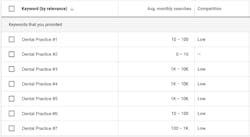As a dentist, diagnosis is as much a part of the job as white coats and sterilization. But where do you begin when the patient is you—and your ailment is business related? Hopefully I can lend some assistance.
My company has helped 6,395 dentists with their marketing in order to improve new-patient numbers, bring in more revenue, and expand overall operations. We’ve helped dentists at every end of the spectrum and in every phase of the practice life cycle, and there’s one thing I can say for sure that applies to every one of them: marketing is best examined not in isolation, but holistically. And that’s exactly what I’ll try to do with this article.
If your practice is suffering from symptoms such as stagnant new-patient numbers and lagging revenue and profits, a number of factors require examining. Let’s review all of them for issues and prescribe a respective treatment plan.
MARKETING FAIL: You lost track of your competition, and they’ve left you in the dust.
This has to be the most overlooked and yet one of the most important factors when it comes to the success of your marketing and your practice—your competition.
In a competitive industry such as dentistry, you have to be on top of what other nearby dentists are doing to bring in new patients, and then use this information to inform your own marketing plan.
Here are a few places to start with your competition research:
• Google dentists in your area and peruse their business listings, taking note of how many reviews they have and how many photos and videos they’ve uploaded.
• Visit the websites of competitors and sign up for their email lists to see the promotions they run, how often they email their lists, and what they communicate.
• Pretend to be a new patient and call to gather info, just like a new patient might. This is called blind shopping and will give you an idea of your competitors’ front-desk procedures and manners.
• Sign up for Google Alerts about your competitors. These alerts will arrive in your inbox whenever a new mention of your competition appears online, making it easy to keep up with them.
• Open up the Google AdWords Keyword Planner and see how many searches your competitors are getting by entering their exact business names into the planner tool. This gives you an indication of how aggressively your competition is marketing by showing you how many people are searching for each of your competitors’ brands specifically per month (figure 1).
We’ve removed the names of each particular dental practice and replaced it with a fake practice, but the numbers in Figure 1 are real. Here is how I read the results of this keyword search:
• Dental Practices #3, #4, and #5 are your real competition. These practices are marketing heavily and generating a lot of interest in their practices specifically.
• Dental Practices #1 and #6 aren’t doing much marketing and probably generate most new patients by referrals and word of mouth.
• Dental Practice #7 may be doing some external marketing, but it isn’t quite on the scale (or hasn’t gathered enough momentum yet) to rank with the bigger players (#3–#5).
You’ll want to keep your eyes on Dental Practices #3, #4, #5, and #7. You’ll also want to look at the searches for your own practice to see how you compare.
If competing practices have a more comprehensive marketing strategy than you, it’s likely that they may be ahead at building trust and credibility within your community. And if this is the case, it may be difficult for you to accelerate your new-patient numbers without making a change.
MARKETING FAIL: You set up your Google My Business listing years ago and haven’t touched it since.
We’ve all been guilty of this at one point or another, but it can be detrimental and here’s why.
Googling you and/or your practice is going to be the first step potential new patients take in their due diligence 99% of the time. It’s also how most people are going to find your website—if you make it past the first Google search, that is.
Here’s what prospects want to see on your Google My Business listing:
• Current and correct contact information
• Current and correct hours of operation
• Photo and videos of you, your staff, your storefront, and your facilities
• Lots and lots of reviews, especially good, recent ones
If your practice’s listing looks dated or inactive, that’s a red flag for prospective patients. It’s effectively a strike against you. Take many more missteps, and your lead will be onto the next nearby dentist before you can say, “But wait, I’ve been meaning to fix that.”
Thankfully, Google makes updating your listing easy. Just go to business.google.com and follow the prompts to upload recent photos and videos of staff. Make it a monthly target for your office manager to upload at least one new photo.
Google even makes creating and updating your listing on Bing (the United States’ second favorite search engine) simple. You can now sync your Bing listing to your Google listing and import everything over from Google to Bing in one go.
Once your listing is freshly updated, generously pour efforts into generating more reviews. Review generation should be a top priority for your front desk. In my experience (and research supports that1), reviews are the biggest determining factor when it comes to getting eyes and clicks on your Google listing.
MARKETING FAIL: Your website’s setup was shortsighted, and now it’s losing tons of hard-earned leads.
Years ago, when many business owners realized that they needed a website, there was a scramble to “get something up.” To add to that, many of the dentists and business owners I’ve spoken to since have become so emotionally damaged by the website development process that they absolutely dread the idea of going through it again. That “new website” project keeps getting pushed further and further down the to-do list. As a result, there are a lot of websites out there that don’t adequately serve the businesses they represent.
Your website is not just a sleek window into your business. In fact, the aesthetics are wholly secondary to your website’s main purpose: to easily and effectively convert the traffic you drive there into a bona fide lead and new patient.
Your website is a tool, a means to an end. Failing to look at it in any other way can be a recipe for disaster. For example, if one of your dental instruments were to break, you would immediately fix or replace it, right? I encourage you to look at your website the same way and not too personally or emotionally.
As you consider whether your website is helping (or hindering) you in your efforts to achieve your goals, open it up in a browser and run through this checklist to ensure it contains all of these elements:
• Clear and consistent contact information at the top and bottom of every page to make it easy for people to connect directly.
• A form above the fold on your home page that requires only a first and last name and email address.i Research shows requiring only these elements (or less) drastically increases a form’s lead capture rate.2 (I suggest an “Ask the Dentist” form to collect leads from patients who might not be ready to book an appointment.)
• Real photos of you, your staff, your facility, and your patients, if possible, because people know a stock photo when they see it. Your website should be building trust instead of setting off alarm bells.
• Relatable biographies for all doctors that establish your medical credentials while still showing that you’re genuine and relatable human beings. I also like to see bios for every staff member, especially the front-desk staff members who greet your patients.
• An integrated appointment booking feature that lets visitors book an appointment right then and there. If someone is ready to become a new patient in your practice, don’t get in the way. Make scheduling as easy as possible.
• Be sure to include your real reviews and ratings to score big credibility points. You can push your Google reviews directly to your website, and I recommend this only after you have a review generation plan in place that will consistently bring in lots of five-star reviews.
• Don’t forget to include a list of your services and insurances accepted. Many people base dental care decisions on these factors, so save your staff and visitors time by making this information readily available.
• Clean and crisp colors that instantly convey dental health. A dark and drab website is not congruent with what dental health should be: soothing, clean, and confidence building.
• Quality content and videos will top off a highly functional dental website by filling it with content that encourages trust and credibility.
Again, the key takeaway when rebuilding (or tweaking) your website is to remember that its entire purpose is to create as many leads and new patients for you as possible. If your website isn’t doing that, it’s failing you.
Be sure to look out for the second part of this article in the January issue. We’ll cover three more big marketing fails that could have impacted your 2019 numbers: internal marketing, external marketing, and your front desk.
Author’s note: Interested in seeing if your website measures up? We just finished a new report, “Does Your Practice Fail the Local Competition Test?” You can download it for free at postcardmania.com/fail.
Note
i. “Above the fold” is an old newspaper phrase that means something is visible without opening or moving a newspaper. In website terms, it means something is visible without scrolling.
References
1. The relationship between local reviews and SEO. Social Media Today website. https://www.socialmediatoday.com/news/the-relationship-between-local-reviews-and-seo/550119. Published March 10, 2019.
2. 7 ways to increase your form field conversion rate (by up to 672%). Neil Patel website. https://neilpatel.com/blog/the-definitive-guide-to-lead-generation-form-optimization. Accessed November 1, 2019.
JOY GENDUSA is the founder and CEO of PostcardMania. Using just postcards, a phone, and a computer, she built PostcardMania from a one-person start-up into an industry leader. PostcardMania serves 78,589 clients, including 5,750 dentists. Need help promoting your practice? Call one of PostcardMania’s dental marketing consultants at (844) 269-1836 or email her at [email protected].








